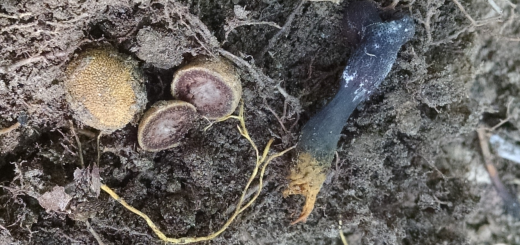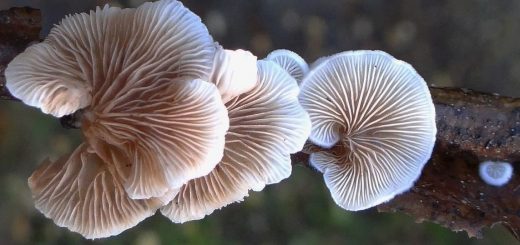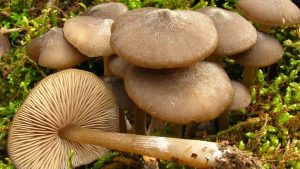#090: Mushroom Edibility
Field guides use three basic categories when discussing mushroom edibility: edible, inedible, and poisonous. These categories are not quite straightforward, so read on to learn about spicy mushrooms, poisonous morels, and toxin types!
Edible:
Edible mushrooms are harmless to most people after being cooked. Morels are a good example of this category. Although they are among the most prized of edible mushrooms, the raw fruitbodies contain toxins which will make you sick. In fact, you should NEVER eat raw morels. Fortunately, these toxins are removed during cooking, making morels safe for most people to eat.
In fact, all but a few edible mushrooms contain toxins that are broken down during cooking. Therefore, it’s a good rule to ALWAYS COOK MUSHROOMS before eating them. Even raw buttons of Agaricus bisporus (the Grocery Store Mushroom) contain hydrazines, which are considered carcinogenic. Thankfully, you probably don’t have to worry about hydrazines at the concentrations found in those mushrooms [you should also remember that there are many other things you regularly eat, breathe, and touch that are considered carcinogenic]. Cooking also helps break down the hard-to-digest chitin found in fungal cell walls. This makes your stomach happy and helps release nutrients locked inside the cells.
Something else that impacts the edibility of mushrooms is an individual’s sensitivity to that mushroom. You may find that you are allergic to a certain mushroom, so it is a good idea to try just a bite of a mushroom the first time. Edible mushrooms are not necessarily edible for everyone, but most people can eat them without any ill effects.
Instead of simply saying “edible,” a field guide may provide more helpful descriptions, such as: “edible – choice” or “edible for some.” These can help you quickly decide whether or not your mushroom is worth trying. If you do decide to eat a foraged mushroom, always check your field guide’s comments section for any special concerns relative to eating that mushroom.
Inedible:
Inedible mushrooms have physical characteristics that discourage consumption. This category includes a vast majority of mushroom species. For most inedible mushrooms, we don’t know whether or not they are poisonous because they are rarely eaten. So what makes a mushroom inedible? Three things: size, texture, and flavor.
Size is pretty self-explanatory. A tiny mushroom is inedible because there is not enough there to consider eating. Some mushrooms only measure a few millimeters across at the most. You would need hundreds of these to make a mouthful, so it is just not worth the effort.
Texture is pretty easy to understand as well. Many mushrooms, particularly the polypores, have tough to leathery to woody textures. You could no more eat these than you could a piece of wood. However, some people do make teas or tinctures out of these mushrooms. If you plan to do this, always check your field guide to make sure your mushroom is not known to be poisonous.
Flavor is the most surprising factor that can make a mushroom inedible. You are probably used to the rather bland taste of A. bisporus, so it may surprise you to learn that mushrooms can be too bitter or too spicy to be eaten. Species in the genus Leucopaxillus, for example, are not poisonous but are listed as inedible due to their extremely bitter taste. Russula emetica and Lactarius piperatus are both too hot and peppery to be eaten, which is just as well because they are both poisonous. A number of other Russula and Lactarius species are similarly spicy but nonpoisonous. There are also a few sour-tasting mushrooms, such as Gomphus floccosus, but the ones I looked up were all listed as poisonous.
Poisonous:
Poisonous mushrooms are known to contain toxins and will sometimes to always make you sick when you eat them, even after cooking. I say “sometimes to always” because there is a lot of variability among poisonous mushrooms. Some mushrooms, like the deadly Amanita virosa, always contain enough toxins to kill a number of people. Others, like Amanita muscaria, are sometimes eaten without experiencing any ill effects. Levels of toxins can also vary between individual mushrooms and between mushrooms of the same species in different areas. Individual sensitivities also play a role, particularly with the mushrooms labeled as “edible for some.” For example, most members of the genus Gomphus (grouped in the chanterelles) are considered poisonous, but some people can eat certain species just fine. Field guides tend to be liberal in their use of the “poisonous” label. This makes sense, as the authors don’t want to get sued. But also, there are so many edible mushrooms to be found that there’s just no reason to risk trying a mushroom that is sometimes poisonous.
Not all poisonous mushrooms are created equal. There are a few deadly poisonous mushrooms out there, but most poisonous mushrooms will just give you food poisoning symptoms (I say “just,” but keep in mind that food poisoning is no picnic). Mycologists have divided mushroom toxins up into eight groups, based on the compounds involved and their physiological effects: 1) Amatoxins, 2) Gyromitrin and MMH, 3) Orellanine, 4) Muscarine, 5) Ibotenic Acid and Muscimol, 6) Coprine, 7) Psilocybin and Psilocin, and 8) gastrointestinal irritants. In the coming weeks, I will go through each of these groups of toxins, so check back later to learn more about poisonous mushrooms!
Reminder:
When collecting for the table, always use a local field guide to identify your mushrooms down to species. If you need a quality, free field guide to North American mushrooms, I recommend Michael Kuo’s MushroomExpert.com. Remember: when in doubt, throw it out!
See Further:
http://www.mykoweb.com/articles/EatingRawMushrooms.html
http://www.botany.hawaii.edu/faculty/wong/BOT135/Lect18.htm
http://www.mushroomexpert.com/hallock_01.html
https://books.google.com/books/about/North_American_Mushrooms.html?id=zjvXkLpqsEgC&hl=en









![#011: Characteristics of Kingdom Fungi [Archived]](https://www.fungusfactfriday.com/wp-content/themes/hueman/assets/front/img/thumb-small-empty.png)

